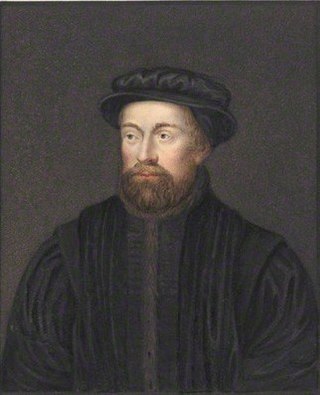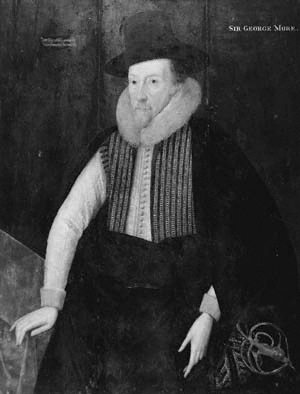Related Research Articles

Thomas Sackville, 1st Earl of Dorset was an English statesman, poet, and dramatist. He was the son of Richard Sackville, a cousin to Anne Boleyn. He was a Member of Parliament and Lord High Treasurer.

Withyham is a village and large civil parish in the Wealden district of East Sussex, England. The village is situated 7 miles south west of Royal Tunbridge Wells and 3.5 miles (5.6 km) from Crowborough; the parish covers approximately 7,500 acres (30 km2).

The Court of Wards and Liveries was a court established during the reign of Henry VIII in England. Its purpose was to administer a system of feudal dues; but as well as the revenue collection, the court was also responsible for wardship and livery issues.

Sir John Baker (1488–1558) was an English politician. He served as Chancellor of the Exchequer from 1545 to his death, having previously been Speaker of the House of Commons of England.

John Paulet, 2nd Marquess of Winchester, styled The Honourable John Paulet between 1539 and 1550, Lord St John between 1550 and 1551 and Earl of Wiltshire between 1551 and 1555, was an English peer. He was the eldest son of William Paulet, 1st Marquess of Winchester and Elizabeth Capel.
Sir Thomas Browne was a Member of Parliament and Chancellor of the Exchequer. Browne's tenure as Chancellor occurred during the Great Bullion Famine and the Great Slump in England. He was executed for treason on 20 July 1460.
John Sackville MP was a member of parliament for East Grinstead, and a local administrator in Essex, Sussex and Surrey. His first wife was Margaret Boleyn, an aunt of Henry VIII's second Queen, Anne Boleyn, and a great-aunt of Queen Elizabeth I.
William Levett was an English clergyman. An Oxford-educated country rector, he was a pivotal figure in the use of the blast furnace to manufacture iron. With the patronage of the English Crown, furnaces in Sussex under Levett's ownership cast the first iron muzzle-loader cannons in England in 1543, a development which enabled England to ultimately reconfigure the global balance-of-power by becoming an ascendant naval force. William Levett continued to perform his ministerial duties while building an early munitions empire, and left the riches he accumulated to a wide variety of charities at his death.
Anne Fiennes, Baroness Dacre was an English gentlewoman and benefactress.

Sir Edmund Walsingham of Scadbury Hall, Chislehurst in Kent, was a soldier, Member of Parliament, and Lieutenant of the Tower of London during the reign of King Henry VIII.

Sir George More was an English courtier and politician who sat in the House of Commons at various times between 1584 and 1625.
Thomas Baker, of Whittingham Hall in Fressingfield, Suffolk and Leyton, Essex, was an English politician.
John Baker was an English politician.

Sir William More, of Loseley, Surrey, was the son of Sir Christopher More. The great house at Loseley Park was built for him, which is still the residence of the More Molyneux family. Of Protestant sympathies, as Sheriff and Vice-Admiral of Surrey he was actively involved in local administration of the county of Surrey and in the enforcement of the Elizabethan religious settlement, and was a member of every Parliament during the reign of Queen Elizabeth I. He was the owner of property in the Blackfriars in which the first and second Blackfriars theatres were erected. He has been described as "the perfect Elizabethan country gentleman" on account of his impeccable character and his assiduity and efficiency of service.
Sir Thomas Pelham, 1st Baronet was an English politician.
Sir Thomas White was an English politician.
Sir William FitzWilliam, of Windsor, Berkshire, was an Irish courtier and Member of Parliament in England. He was Chief Gentleman of the Privy Chamber to Edward VI of England; Deputy Chancellor of Ireland; Lieutenant of Windsor Castle; Keeper of Windsor Great Park and Lord Lieutenant of Berkshire.
Sir Richard Baker, was an English politician.
Chidiock Paulet was an English politician and Captain of Portsmouth. He was born the third son of William Paulet, 1st Marquess of Winchester and educated at the Inner Temple.
Sir Christopher More was an English administrator, landowner, and Member of Parliament. More was the son of John More, a London fishmonger, and his wife, Elizabeth. He was active in local administration in Sussex and Surrey, and from 1505 until his death held office in the Exchequer, rising in 1542 to the post of King's Remembrancer. His sister, Alice More, was the fourth wife of Sir John More, father of Sir Thomas More.
References
- Brydges, Edgerton (1812). Collins Peerage of England. Volume VI. London: F.C. and J. Rivington, Otridge and Son et al.
- Hasler, P.W., ed. (1982). The History of Parliament, Commons, 1558–1603, Vol. III. Secker & Warburg. ISBN 0-11-887501-9.
- "History of Parliament SACKVILLE, Richard II (by 1507-66) of Ashburnham and Buckhurst Sussex". The History of Parliament. Archived from the original on 4 February 2012. Retrieved 16 September 2011.
- Horsfield, Thomas Walker (1834). The History, Antiquities and Topography of the County of Sussex (repr. 2004). Bakewell: Country Books. ISBN 978-1-906789-16-9.
- Jack, Sybil M. (2004). "Sackville, Sir Richard". Oxford Dictionary of National Biography (online ed.). Oxford University Press. doi:10.1093/ref:odnb/24447.(Subscription or UK public library membership required.)
- Richardson, Douglas (2011). Everingham, Kimball G. (ed.). Magna Carta Ancestry: A Study in Colonial and Medieval Families. Vol. III (2nd ed.). Salt Lake City: Douglas Richardson. ISBN 978-1449966393.
- The Weald of Kent, Surrey and Sussex (2003). "The ancestral pedigree of Winifred Paulet" . Retrieved 2 September 2011.
- UK Government (2020). "Past Chancellors". UK Government. Retrieved 5 September 2020.
